
Thelymitra aristata, commonly called the great sun orchid, is a species of orchid that is endemic to south-eastern Australia. It has a single large, thick leaf and bracts and up to forty crowded blue or purplish flowers with darker veins.
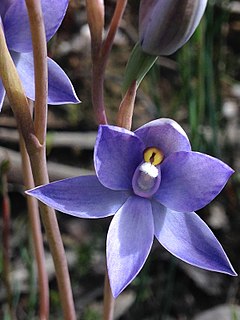
Thelymitra megacalyptra, commonly called the plains sun orchid, is a species of orchid that is endemic to eastern Australia. It has a single erect, fleshy leaf and up to fifteen blue to purplish, sometimes lilac, pink or white flowers with white tufts on top of the anther. It is known as Thelymitra megcalyptra by some authorities.
Thelymitra batesii, commonly called the plump sun orchid, is a species of orchid that is endemic to South Australia. It has a single fleshy, channelled, dark green leaf and up to eight mauve to bluish purple flowers that are pinkish with darker stripes on the back. The unopened flower buds are distinctly plump.

Thelymitra granitora, commonly called the coastal granite sun orchid or coastal sun orchid, is a species of orchid in the family Orchidaceae and is endemic to the south-west of Western Australia. It has a single short, curved and channelled dark green leaf and up to eight relatively large pale blue or white, self-pollinating flowers with white mop-like tufts on the top of the anther.
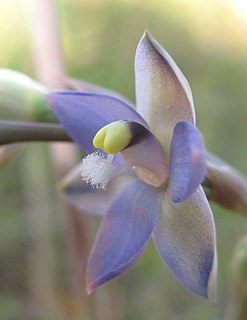
Thelymitra peniculata, commonly called the trim sun orchid, is a species of orchid that is endemic to southern eastern Australia. It has a single long, erect, fleshy, channelled leaf and up to eighteen deep blue to purple self-pollinating flowers.
Thelymitra reflexa, commonly called the reflexed sun orchid, is a species of orchid that is endemic to Victoria. It has a single erect, fleshy, channelled leaf and up to six bluish purple flowers. The sepals and petals are strongly turned back towards the ovary but only on hot days when the flowers open.
Thelymitra viridis, commonly called the green sun orchid, is a species of orchid that is endemic to Tasmania. It has a single erect, fleshy, channelled leaf and up to seven small self-pollinating pale blue to pale purplish flowers. The rest of the plant is a pale green colour.
Thelymitra inflata, commonly called the inflated sun orchid, is a species of orchid that is endemic to south eastern Australia. It has a single long, erect, linear leaf and up to six dark blue to purplish flowers with a very inflated lobe on top of the anther.
Thelymitra lucida, commonly called the glistening sun orchid, is a species of orchid that is endemic to south eastern Australia. It has a single erect, fleshy leaf and up to seven dark blue flowers with the sepals a lighter blue than the petals.
Thelymitra polychroma, commonly called the rainbow sun orchid, is a species of orchid that is endemic to Tasmania. It has a single narrow, fleshy leaf and up to four blue and mauve flowers with darker veins. It grows in windswept heath and swampy areas and the flowers are self-pollinated.
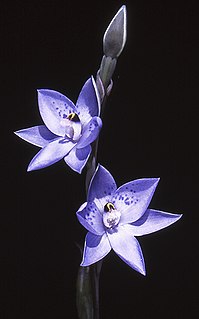
Thelymitra simulata, commonly called the collared sun orchid, is a species of orchid that is endemic to south-eastern Australia. It has a single fleshy, channelled leaf and up to six blue flowers with small darker spots. It grows in higher altitudes places part and the flowers have a purple lobe with a yellow tip on top of the anther.
Thelymitra spadicea, commonly called the browntop sun orchid, is a species of orchid that is endemic to Tasmania. It has a single erect, fleshy leaf and up to four relatively small blue flowers with small darker spots and an elongated lobe on top of the anther.
Thelymitra sparsa, commonly called the wispy sun orchid, is a species of orchid that is endemic to Tasmania. It has a single erect, fleshy leaf and up to six relatively small blue flowers with a few small darker spots. The flowers are self-pollinated and open only slowly on hot days. The species is restricted to a few restricted montane sites in south-eastern Tasmania.
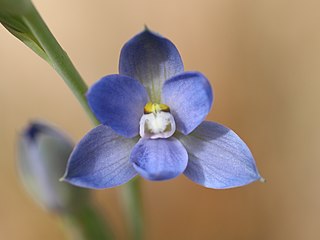
Thelymitra improcera, commonly called the coastal sun orchid, is a species of orchid that is endemic to south-eastern Australia. It has a single erect, fleshy leaf and up to eight relatively small pale to bright blue flowers on a short flowering stem. The lobe on top of the anther is unusually short and lobed.
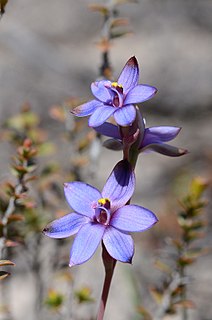
Thelymitra azurea, commonly called the azure sun orchid, is a species of orchid that is endemic to south-eastern Australia. It has a single fleshy, grass-like leaf and up to ten dark azure blue flowers with darker veins. The lobe on top of the anther has a toothed or warty tip.
Thelymitra jonesii, commonly called the skyblue sun orchid, is a species of orchid that is endemic to Tasmania. It has a single erect, fleshy, linear, dark green leaf and up to six relatively small light blue to azure blue flowers with darker veins. It is a rare orchid known from only four scattered locations in moist coastal heath.
Thelymitra latiloba, commonly called the wandoo sun orchid or wandoo shirt orchid, is a species of orchid in the family Orchidaceae and endemic to the south-west of Western Australia. It has a single erect, fleshy, channelled, dark green leaf and up to twelve blue flowers with darker blue veins and sometimes flushed with mauve. The lobe on top of the anther is wavy.
Thelymitra occidentalis, commonly called the western azure sun orchid or rimmed orchid, is a species of orchid in the family Orchidaceae and is endemic to the south-west of Australia. It has a single erect, fleshy, channelled, dark green leaf and up to fifteen blue flowers with darker blue veins and sometimes flushed with pink. The lobe on top of the anther has a wavy, yellow crest.
Thelymitra erosa, commonly called the striped sun orchid, is a species of orchid that is endemic to Tasmania. It has a single erect, fleshy dark green leaf and up to eight moderately large dark blue to purplish or pink flowers with darker veins. The column arms have irregular lobes.
Thelymitra incurva, commonly called the coastal striped sun orchid, is a species of orchid that is endemic to south-eastern Australia. It has a single erect, dark green grass-like leaf and up to seven relatively large, pale blue flowers lacking the darker veins of some other thelymitras, especially the otherwise similar striped sun orchid. It grows in coastal areas of far south-eastern New South Wales and north-eastern Victoria.







